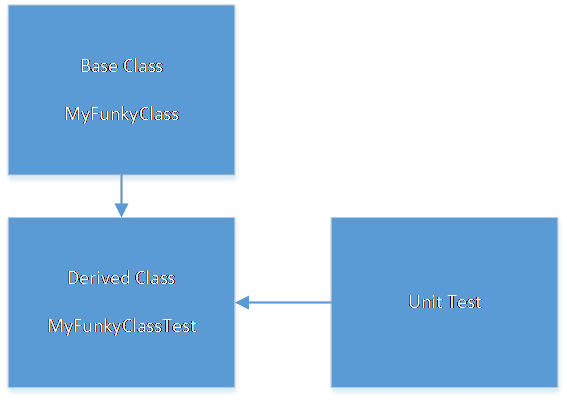I have previously written about how to, effectively, subclass using Nsubstitute; in this post, I’ll cover how to partially mock out that class.
Before I get into the solution; what follows is a workaround to allow badly written, or legacy code to be tested without refactoring. If you’re reading this and thinking you need this solution then my suggestion would be to refactor and use some form of dependency injection. However, for various reasons, that’s not always possible (hence this post).
Here’s our class to test:
public class MyFunkyClass
{
public virtual void MethodOne()
{
throw new Exception("I do some direct DB access");
}
public virtual int MethodTwo()
{
throw new Exception("I do some direct DB access and return a number");
return new Random().Next(5);
}
public virtual int MethodThree()
{
MethodOne();
if (MethodTwo() <= 3)
{
return 1;
}
return 2;
}
}
The problem
Okay, so let’s write our first test:
[Fact]
public void Test1()
{
// Arrange
MyFunkyClass myFunkyClass = new MyFunkyClass();
// Act
int result = myFunkyClass.MethodThree();
// Assert
Assert.Equal(2, result);
}
So, what’s wrong with that?
Well, we have some (simulated) DB access, so the code will error.
Not the but a solution
The first thing to do here is to mock out MethodOne(), as it has (pseudo) DB access:
[Fact]
public void Test1()
{
// Arrange
MyFunkyClass myFunkyClass = Substitute.ForPartsOf<MyFunkyClass>();
myFunkyClass.When(a => a.MethodOne()).DoNotCallBase();
// Act
int result = myFunkyClass.MethodThree();
// Assert
Assert.Equal(2, result);
}
Running this test now will fail with:
Message: System.Exception : I do some direct DB access and return a number
We’re past the first hurdle. We can presumably do the same thing for MethodTwo:
[Fact]
public void Test1()
{
// Arrange
MyFunkyClass myFunkyClass = Substitute.ForPartsOf<MyFunkyClass>();
myFunkyClass.When(a => a.MethodOne()).DoNotCallBase();
myFunkyClass.When(a => a.MethodTwo()).DoNotCallBase();
// Act
int result = myFunkyClass.MethodThree();
// Assert
Assert.Equal(2, result);
}
Now when we run the code, the test still fails, but it no longer accesses the DB:
Message: Assert.Equal() Failure Expected: 2 Actual: 1
The problem here is that, even though we don’t want MethodTwo to execute, we do want it to return a predefined result. Once we’ve told it not to call the base method, you can then tell it to return whatever we choose (there are separate events - see the bottom of this post for a more detailed explanation of why); for example:
[Fact]
public void Test1()
{
// Arrange
MyFunkyClass myFunkyClass = Substitute.ForPartsOf<MyFunkyClass>();
myFunkyClass.When(a => a.MethodOne()).DoNotCallBase();
myFunkyClass.When(a => a.MethodTwo()).DoNotCallBase();
myFunkyClass.MethodTwo().Returns(5);
// Act
int result = myFunkyClass.MethodThree();
// Assert
Assert.Equal(2, result);
}
And now the test passes.
TLDR - What is this actually doing?
To understand this better; we could do this entire process manually. Only when you’ve felt the pain of a manual mock, can you really see what mocking frameworks such as NSubtitute are doing for us.
Let’s assume that we don’t have a mocking framework at all, but that we still want to test MethodThree() above. One approach that we could take is to subclass MyFunkyClass, and then test that subclass:
Here’s what that might look like:
class MyFunkyClassTest : MyFunkyClass
{
public override void MethodOne()
{
//base.MethodOne();
}
public override int MethodTwo()
{
//return base.MethodTwo();
return 5;
}
}
As you can see, now that we’ve subclassed MyFunkyClass, we can override the behaviour of the relevant virtual methods.
In the case of MethodOne, we’ve effectively issued a DoNotCallBase(), (by not calling base!).
For MethodTwo, we’ve issued a DoNotCallBase, and then a Returns statement.
Let’s add a new test to use this new, manual method:
[Fact]
public void Test2()
{
// Arrange
MyFunkyClassTest myFunkyClassTest = new MyFunkyClassTest();
// Act
int result = myFunkyClassTest.MethodThree();
// Assert
Assert.Equal(2, result);
}
That’s much cleaner - why not always use manual mocks?
It is much cleaner if you always want MethodThree to return 5. Once you need it to return 2 then you have two choices, either you create a new mock class, or you start putting logic into your mock. The latter, if done wrongly can end up with code that is unreadable and difficult to maintain; and if done correctly will end up in a mini version of NSubstitute.
Finally, however well you write the mocks, as soon as you have more than one for a single class then every change to the class (for example, changing a method’s parameters or return type) results in a change to more than one test class.
It’s also worth mentioning again that this problem is one that has already been solved, cleanly, by dependency injection.
